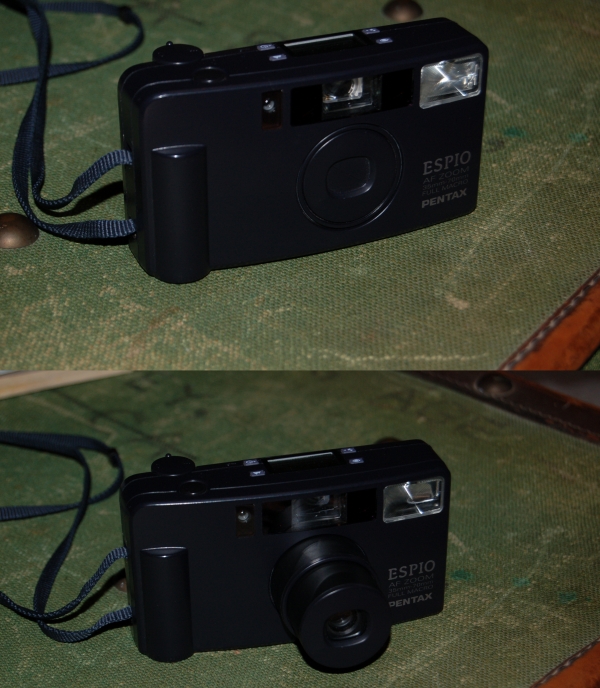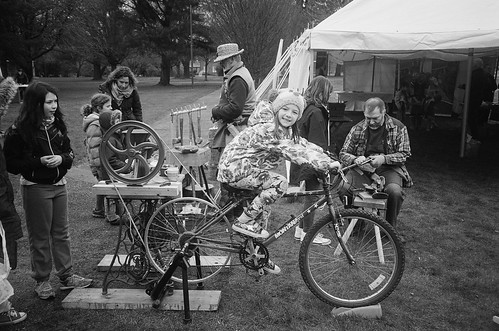This Camera has been my ‘can’t believe it’s not butter’ moment of the Poundland Challenge. It turned up with a pack of other cameras as s 99p Job lot. Whilst others have made that job lot quite a good deal this was the hidden cracker. But why has this AF zoom compact so impressed me.

Pentax stuck together one neat camera ( also sold in the US as the Pentax IQZoom 70XL). At first glance you might be lulled into thinking this is a 21st Century 35mm compact or a bulkier digital given it svelte matt black body. But nope – this hails from 1992 and was the first in a line of highly successful shooters from Pentax. Whilst later models had similar styling to other rivals this oozes a different class. The only camera matching this was the Olympus µ[mju:] (stylus) series IMHO.

At first glance it specs very closely to the Canon Sure Shot 60 Zoom. It is an autofocus X2 zoom with all singing and dancing auto exposure. But not only does it kick the Canon into touch stylistically, I goes on and converts the try with its lens and functions. And boy does it have functions
Pentax Espio AF Zoom Specs
- Lens: 35-70mm 1:3.8-8
- Focus : Infra-Red AF
- Focus : 0.6m to ∞
- DX Coding: 25-3200 ISO *
- Shutter: 1/5-1/400 + Bulb
- EV 100 : 6.5-17 (35mm)¹
- Exposure: Auto
- Battery : 1 x CR123A
*Non DX films code at 25 ISO ¹ slow shutter speed
You select these by means of 4 buttons around the Large LCD. You get the usual auto, flash on, flash off setting and there is a separate control for red eye reduction. Then things get interesting. There is an landscape shot mode and a bewildering array of timer modes including a neat option that takes a picture on wide and then auto zooms & takes another. Or there is the time lapse mode.

Phew !! and that’s not all. You can even knock into bulb mode, slow syncro mode for flash, repeat shot mode and it also has a Backlight function (+1.5EV). My only quibble is no flexible EV compensation but that really isn’t an option you’ll find on compacts of this era. There was a databack version too.

Half depress the shutter and an green LED on right of viewfinder tells you if you’ve got focus (or blinks if you’re not or too close) and also locks focus in the central focusing spot. A red LED on the left tells you flash is ready (blinks if charging). The zoom is driven by a rocker switch. Bit slow and noisy by 21st century standards but fine for 1992.

And then there’s the lens.
8 element in 7 groups and with the AF is pretty sharp at both near and far. This is a corker and doubts about it. Sharp and accurate although you’ll need to engage panorama mode to get the best out of distance shooting. Up close and it is stonking as you can see. The flash is pretty typical so good for snapshots fairly close about 2m away but less good beyond.
This is a truly great late 20th century compact. It’s only failings really is the usual X2 length zoom but otherwise it’s the Dog’s Boll*&ks

Why Buy
- Crisp images
- Stylistically great
- All the features you want
Why not
- Only x2 zoom
- Uses slightly more expensive CR123A battery
- Bulkier than a µ[mju:]
What I paid, got & sold for
- Part of group for 99p + £5 ( effectively less than £1 inc postage)
- Came with strap
- It’s a keeper
Alternatives
- Canon Sure Shot 60 – Typical 90’s zoom compact
- Olympus Superzoom 80G – small zoom 21st century compact
- Olympus µ[mju:] series – ultra compact but light leak prone
Helpful links
- Manual at Mike Butkus’s site
- Pentax Espio AF Zoom at Camera-wiki.org
- Pentax Espio Group at Flickr

I recently got one of these too, and agree about how promising it is – arguably it feels like the best Espio Pentax made and none of them I’ve come across are duds.
I’m really keen to see how my first roll turns out.
It’s a great camera and I’m more than happy that people are at long last fully appreciating the Pentax Espio range. There are some ugly looking brutes in the range but there are some absolutely beautiful feature packed cameras, which can give the cult compacts a good run for their money as well as saving you a bundle of cash.
The Pentax Espio 80 is another great little camera but is hard to come by nowadays. The 120mi, 150SL & 170SL with their brushed aluminium fronts will give some well known SLR’s a run for their money. Luckily at the moment the Espio range is cheap but i do notice that prices have started to creep up.
I agree about the Espios. My first zoom compact back in 2012 was an Espio 120Mi and I was really impressed with its compact size and decent photographs. I also had a 928 (great 28mm lens and range of functions but rather bulky) and 24EW (arguably the best Espio made with a ton of features and a really wide 24mm lens).
It’s taken me about 3.5 years a a few dozen cameras to come back and realise the Espios are amongst the very best.
I recently got a job lot, including a 115M which is probably the smallest and cutest Espio I’ve come across. But features wise its surpassed by the AF Zoom, and the VF and handling is better with the AF Zoom too.
You can’t go far wrong with any Espio though really, especially as they are such fantastic value and can often by had for 99p (my AF Zoom was 95p + P&P!)
Oh I like your Espio 80 by the way, has an old school kind of class to it!
Like you Dan I’ve tried numerous AF zooms via the Poundland challenge but this is the one that stuck. Oddly before the Poundland challenge I wouldn’t have bothered with one (although I did keep a Samsung 105xl that I got with a joblot of expired film and cameras). Now the Espio is one of my go cameras when I need something accurate for a night or trip out
I managed to source one of these from eBay but unfortunately despite looking in good cosmetic condition, I was disappointed with the shots from the roll of film I put through it – perhaps I have been unlucky and got a duff one. The shots were all a bit soft and pretty dark considering they were taken on bright sunny April days – the vivid colour subjects and opportunities for rendering sharp lines and good contrast were all very muted on the final images. I was using Poundland Vista 200 film and comparing them to a Pentax Pino I had also bought, both films taken at the same time and processed at the same time in Snappy Snaps. The Pino was better than the Espio, but neither were as sharp and clear as a much older Olympus Trip 🙂
It has been a worry for me recently Harry. Folk like me review 2nd hand equipment but are not likely to buy more than one of the same model. I’ve mused about this before especially with the Olympus XA2. I’ve had 3 with 2 pretty good ones but the middle one just didn’t work as well. If I’d got just it I’d have been convinced the camera wasn’t that sharp and struggled in some light conditions. No obvious probs – fired as normal and long shutter times seemed okay but just not sharp.
I’ve now 2 LC-A both of which have been CLA’d by Roger Lean. Superficially they produce typical Lomo LC-A shots but there are subtle differences.
I’m aware some cameras I’ve reviewed other reviews have differed so it does make me think there is risk of the munted model review.
The Espio I generally find pretty good. Not quite mju league and like all AF zoom compacts weaker at distant shots. Pretty good close up mind.
Alan, I should emphasise that absolutely no criticism is intended – just a data point. It is always a bit of a lottery using secondhand cameras. In fact the only conclusion to draw is how much I like the pictures produced by an old Olympus Trip I have (and in fact also an Olympus Pen EE2 half frame), so maybe I am more a fan of the 60s than the 80s/90s, lol. I think the shots you have produced from the various low cost cameras of yesteryear are phenomenal, and there is a lot to be said for the skill of the photographer no matter what the pictures are actually taken on! More power to you and I look forward to future articles.
Always hard to beat pre 90’s Olympus glass (the mju series were a times pretty good too). My EE-2 has been my most shot camera in the last 12 months.
Harry, I have an Espio AF Zoom and have been really pleased with mine. The lens isn’t super stunning – I have used maybe half a dozen fixed lens compacts that perform better – but for a zoom, and with its features, size and ergonomics, it remains one of my favourite compacts, and possibly my favourite AF zoom compact.
I’ve had the larger Zoom-70 series too, which are also really good, but the Espio does everything and more in a much smaller and lighter body.
The Olympus Trip 35s, when you get their sweet spot, are capable are stunning results and punch well above their weight. I’d not be surprised at all to see a Trip with its 40/2.8 Zuiko lens regularly outperform any Espio lens. But they’re different types of cameras.
You might have been unlucky and got a poor example of the AF Zoom, or maybe you just expected more than it was ever going to be capable of.
If you want really great results from a compact, I’d go with a fixed lens 35/2.8 every time.
Some of these I’ve been most happy with have been the Minolta AF-S, Canon MC, and Rollei FF-3D AF Super (35/3.2), to name three. All should comfortably outperform the Espio, results wise. But none of these are zooms, or have multiple exposure mode, from example, so again it depends what you’re looking for… If you want a great 35-70mm zoom, the Espio AF zoom is probably as good as is there is out there.
Hi Alan,
if you leave it on for so long that it powers down, does it keep the flash settings when you power it back up?
This is a feature of the earlier chunkier espio 120. It forgets the flash settings if you switch it off, but keeps them if it switches itself off
It does indeed Hamish. Like your lamented 120 it resets when manually turned off but if energy saving powers down it keeps the setting. Odd quirk in series methinks
Must be noted that this camera features a BULB mode, either with or without a flash. To me personally this is a huge win, as one can gain SLR-like control for some long-exposure flash shots.